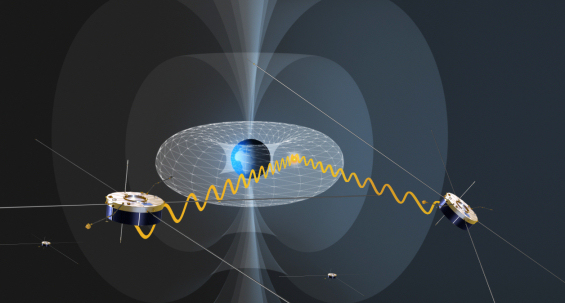Cluster takes a tilt at radio wave sources
26 November 2013
A new study using ESA's Cluster mission has shown improved precision in determining the source of a radio emission produced by the Earth. The experiment involved tilting one of the four identical Cluster spacecraft to measure the electric field of this emission in three dimensions for the first time.
 |
| The Cluster spacecraft in special configuration for observing Earth's radio wave emissions in May 2008. Credit: ESA |
Two main types of radio waves, with different generation mechanisms, are known to be produced within the Earth's magnetosphere: the auroral kilometric radiation (AKR) and the non-thermal continuum (NTC) radiation. Both have been observed in space around Earth since the 1970s, and within the magnetospheres of Jupiter, Saturn, Uranus, and Neptune since the late 1980s. Radio waves can travel long distances, carrying with them useful information from the regions of the magnetosphere where they are generated.
A new study, published in Annales Geophysicae, presents two different approaches for locating the source of NTC, with differing results. The researchers analysed radio waves measured by the WHISPER instruments on board the four Cluster spacecraft. They showed that classical triangulation, in this case using three of the spacecraft situated thousands of kilometres apart, can lead to a source location nowhere near the boundaries where NTC generation occurs. NTC can emit from the plasmapause, and possibly from the magnetopause. The erroneous source location, far from these boundaries, given by triangulation is attributed to small deviation from the assumed polarization of the emission.
The second method using the new 3D electric field measurements indicated a source located along the plasmapause at medium geomagnetic latitude, far away from the source location estimated by triangulation. Cluster observations reveal that this NTC source emits from the flank of the plasmapause towards the polar cap. Understanding the source of NTC waves will help with the broader understanding of their generation, amplification, and propagation.
The new 3D method involved placing two of the four identical Cluster spacecraft, C3 and C4, within 50 km of each other so that they could be considered as a single observatory.
"While the other spacecraft remained in their normal positions with their spin plane roughly level with the ecliptic plane, the spin axis of C3 was tilted to an angle of 45 degrees, its spinning antenna pointing to directions outside the ecliptic plane," explains Pierrette Décréau, who led the study. "This allowed the radio waves to be measured locally in three dimensions by the C3 - C4 observatory, with two identical 88-m long-boom antennas capable of catching faint waves, for the first time in space."
There were particular dangers in operating the spacecraft like this, since the solar panels should always be exposed to sunlight. Spacecraft operators at ESOC took care to ensure C3 was operating safely.
"Because we needed to keep enough of the solar panels exposed to sunlight, we had to choose the right time of the year for the data to be collected and it could only be done for a period of one month," says Philippe Escoubet, Project Scientist for Cluster. "It was a high-risk manoeuvre as it was possible that something might have prevented us from being able to return C3 to its original orientation, which obviously would have had a huge impact on the operation of Cluster.
"On the other hand, the tilt experiment also shows the value of a mission like Cluster, in that it can be used for new ideas that weren't even being thought of when the mission was conceived," he says.
SCOPE, a possible future mission under study by the Japanese Space Agency (JAXA) would use similar techniques to research space plasma physics. The proposed mission would comprise one large spacecraft with four smaller ones operating around it, one of them tilted 90 degrees. This configuration would be able to collect data in three dimensions for the study of shocks, boundary layers and magnetic reconnection in the magnetosphere.
About Cluster
Cluster is a constellation of four spacecraft flying in formation around Earth. It is the first space mission able to study, in three dimensions, the natural physical processes occurring within and in the near vicinity of the Earth's magnetosphere. Launched in 2000, it is composed of four identical spacecraft orbiting the Earth in a pyramidal configuration, along a nominal polar orbit of 4 × 19.6 Earth radii (1 Earth radius = 6380 km). Cluster's payload consists of state-of-the-art plasma instrumentation to measure electric and magnetic fields over wide frequency ranges, and key physical parameters characterising electrons and ions from energies of near 0 eV to a few MeV. The science operations are coordinated by the Joint Science Operations Centre (JSOC) at the Rutherford Appleton Laboratory, United Kingdom, and implemented by ESA's European Space Operations Centre (ESOC), in Darmstadt, Germany.

